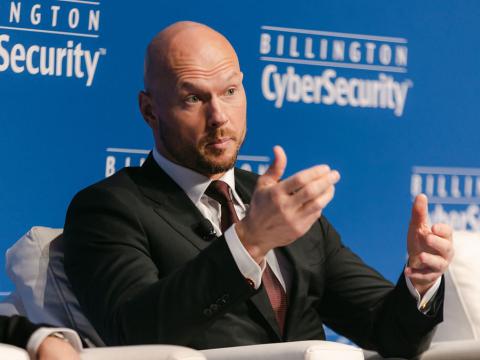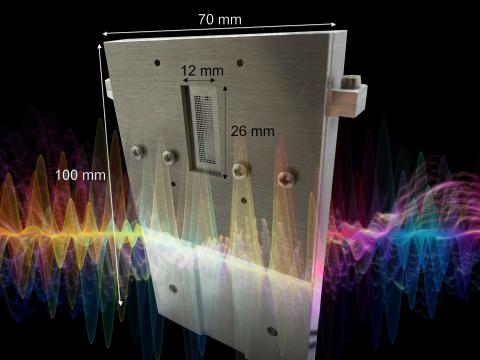Exploiting Dormant Bandwidth Enables Expanded Video Usage
Next-generation communications technology employs existing infrastructure, reduces business travel.
The same wires that carry voice transmissions to individual telephones within an organization are now delivering data, television-quality video and stereo-quality sound directly to the desktop. This allows businesses and agencies to provide multipoint videoconferencing, video-broadcast and video-on-demand capabilities to employees without installing additional infrastructures or overloading existing information technology components or networks.
Service providers and manufacturers recognize the bottom-line benefits of expanding video capabilities and usage. Meetings between individuals in several locations can occur without travel expenses or downtime. An individual in one location can present material immediately and simultaneously to a large group at a different site or to many people in their offices. New employees can receive training independently as soon as they arrive on the job. Personnel can access current news items as events unfold. Service areas can be extended as distance education capabilities bring classes to an online audience or technical support directly to the customer. The results are the same: lower costs, increased revenue and less time spent on unproductive tasks.
Until recently, bringing this effective tool to an organization on an enterprisewide basis involved installing a new infrastructure or exhausting network resources. Today, by taking advantage of the unused spectrum that is available on the standard twisted-pair wiring that currently provides telephone service, government agencies and commercial entities are incorporating video into the way they do business. Video transmission occurs without tying up telephone lines or interfering with the network.
One company that produces both the hardware and software for video delivery systems is Objective Communications Incorporated, Portsmouth, New Hampshire. Company officials relate that Steven Rogers, the firm’s founder and chief technology officer, developed this patented technology, and they claim it is the only system of its kind currently available. Other vendors offer videoconferencing capabilities; however, say company officials, these systems use spare pairs in the local area network (LAN) wiring or involve the LAN itself.
Several organizations have installed Objective Communications’ video delivery equipment, and its effectiveness is also being evaluated through pilot programs in additional locations.
Known as VidPhone, the system is composed of three primary components that provide video capabilities within an organization’s internal telephone environment. The site could be a college campus, a single building or a group of buildings that share the same telephone system. The service can be extended to locations outside the immediate surroundings by using integrated services digital network and asynchronous transfer mode technologies.
The VidPhone switch resembles a private branch exchange and makes physical connections into the existing telephone wiring network. It supports up to 64 total ports of full-duplex video, audio and collaborative data and enables direct access to video sources such as videocassette recorders, digital videodisc players and satellite feeds. Because the channels are nonblocking, all users on the switch can continue to conduct telephone communications during video transmission.
The centerpiece of the system is the Station Adapter Module-1 (SAM-1). It is the modem that transmits video, audio and data on the twisted-pair telephone wiring by narrow deviation frequency modulation of the baseband video signal and subsequent filtering that suppresses an upper sideband corresponding to a color component of the original video signal. Two video signals are simultaneously transmitted, each with an approximate bandwidth of 6 megahertz and shifted to a noninterfering frequency location within the approximately 20 megahertz of usable bandwidth on the wire. This enables full-duplex operation. The device plugs into the existing telephone jack, the telephone and a computer’s central processing unit, compatible camera or National Television Standards Committee and phase alternate line television monitor.
David Martin, vice president of sales for Objective Communications, uses a highway analogy to describe how the technology works. “Around Washington, D.C., for example, you have the beltway with four lanes. Use this to picture a telephone wire. Conversations on the telephone would take place in the breakdown lane. The four remaining lanes are open to be used for transmission of data and video,” he explains.
A 32-bit peripheral communications interface audio/video card connects the SAM-1 and the personal computer screen. The card overlays the video from the SAM-1 onto the video graphic array screen of the computer and features connectors for the camera and speakers. A small color video camera, which feeds into the modem, can be mounted on top of the monitor and houses the stereo microphone that is used for local audio pickup.
The VidPhone station, which consists of any video-enabled endpoint that is connected to the SAM-1, is the final component of the system. In the computer configuration, the station’s software operates in Windows 95 or Windows NT environments. The user interface supplies access to all video capabilities. Because the service is delivered via telephone lines, the local area network is not involved; however, the software that must be installed on individual computers requires approximately 20 megabytes of space.
When installed on category-3 wiring, television-quality video can be delivered to campus stations within 1,000 feet of the switch. For service up to 2,000 feet from the switch, category-5 wiring must be in place. Each Station Adapter Card-5 delivers full-motion, uncompressed and latency-free video within the campus environment at 30 frames per second to up to five stations within the VidPhone network. Multiple cards can be installed. Video quality between systems that reside off site depends on the access lines in place.
A directory that includes the VidPhone list of all available people and devices is used to initiate communications. By clicking on a name, a point-to-point video call is placed. If the receiver has selected the automatic-answer feature, the communications line immediately opens on the receiver’s computer. The manual-answer option requires the person receiving the call to click on the appropriate button to accept the call.
A VidServer gateway allows users to select a prerecorded video or to watch one of several broadcast channels.
Although all these capabilities are provided over a single telephone wire, users can read and send electronic mail, conduct a traditional audio telephone conversation and participate in a videoconference simultaneously.
Last October, the company formed a strategic partnership with Unisys Corporation, McLean, Virginia, to market and sell the complete line of VidPhone products to the federal government. Under the terms of the agreement, Unisys Federal Systems is Objective Communications’ preferred systems integrator for the U.S. government market. The companies also have agreed to collaborate on future developments and co-marketing initiatives. The VidPhone System is installed in the Unisys Center of Excellence in McLean.
Several factors are driving the burgeoning interest in video capabilities, Terri Weipert, director of business development for video solutions, Unisys Federal Systems, says. Her department offers several video product lines to federal agencies and helps them determine how video can enhance efficiency.
“There is pressure on information technology managers to improve productivity. People are asking their IT [information technology] team, ‘What else can you do for me?’ Also, budgets are being restrained. They [IT staff] can’t add anything but are being asked, ‘What can you do to make me more productive with what I have already?’ There is a network in place so people are looking at what else can be done with it,” Weipert explains.
Organizations are also trying to determine how to conduct efficient meetings with “virtual teams,” and easy-to-use, high-quality videoconferencing technology is one solution that combines both personnel and technology resources to achieve this goal. It also satisfies what Weipert calls the human factor—the preference people have for face-to-face communications.
Prior to the teaming announcement, Unisys assisted Objective Communications in securing a contract for several VidPhone Systems for the U.S. Second Circuit Court of Appeals in New York. The courts expect the video capabilities to result in several benefits, Martin explains. Attorneys who now travel from as far as Vermont to argue cases in New York will be able to present material remotely, saving both time and money. Arraignment hearings can take place without the prisoner being in the courthouse through videoconferencing. This eliminates the expense and hazard of transporting prisoners from one site to another for brief proceedings. The system also enables district court judges to conduct administrative meetings from their chambers with participants in different locations, he adds.
This initial success and federal judiciary and military customers’ requests for the products prompted Unisys to award Objective Communications a $1 million sales order for a complete line of VidPhone products for federal government customers.
The companies also are working with a U.S. Army research and development agency, and James F. Bunker, president and chief executive officer, Objective Communications, believes the technology could be employed to provide real-time battlefield situational awareness data to commanders. In addition, through video relays, Pentagon officials also could view the scene. The current VidPhone switch design would allow military commands to configure the systems so that designated command levels could only view certain types of information, Bunker offers.
The Small Business Administration, Federal Aviation Administration and Bureau of Alcohol, Tobacco and Firearms are among the many government agencies the company has contacted.
In the commercial market, the Inter-American Development Bank, Washington, D.C., purchased the VidPhone System to facilitate communications within its two headquarters buildings as well as with offices in South America. More than 20 organizations currently are conducting pilot programs to evaluate how the system would improve their operations.
According to Bunker, many people have not yet embraced video capabilities because of video and audio quality, the drain on technology resources and systems costs. “When the quality is bad, people just get fed up and use the telephone,” he offers. The VidPhone System addresses the first two issues by providing television-quality video without requiring additional infrastructures.
Because the company’s systems have only been available since late last year, customers have not had adequate time to gather metrics about the tangible savings in money or time. But using the cost of a single seat, which currently is $3,000, and the standard depreciation of equipment of three years, Bunker describes the potential reduction in travel expenses.
“If one executive takes a one-week business trip cross country, you have the airfare expense, plus the hotel, plus dining. A round-trip ticket to the West Coast can now be around $2,000. If the VidPhone eliminates only one trip a year, taking into consideration a three-year depreciation, it has already paid for itself,” he offers.
Despite this justification, many organizations are still reluctant to invest in video technologies. “The people we are talking with want to see this at a cost that is half of other desktop electronics. We’re not there yet, but in five years or so, the pricing will be in the range of an inexpensive PC, at about $500 per seat,” Bunker says.
Weipert agrees that because of both the maturation pace and cost of technology, widespread video communications use will probably not take place for at least four years. However, corporate executives currently are examining immediate requirements for video capabilities and evaluating the benefits they would provide.



